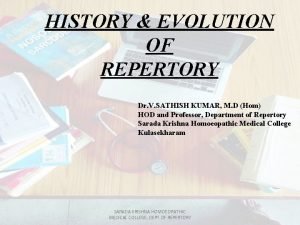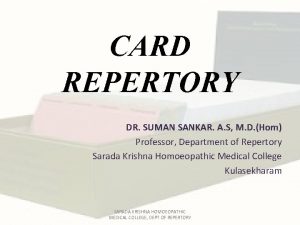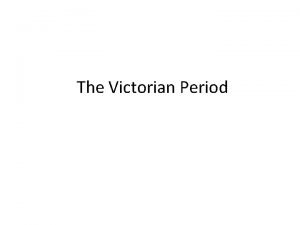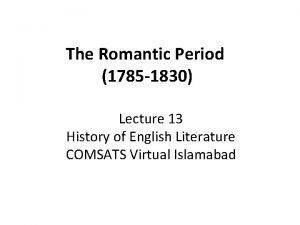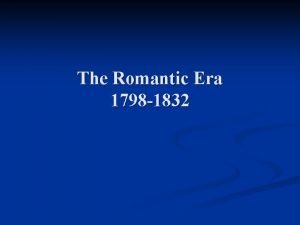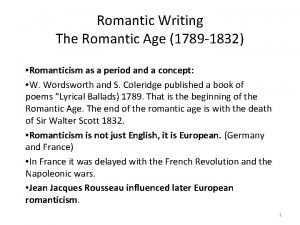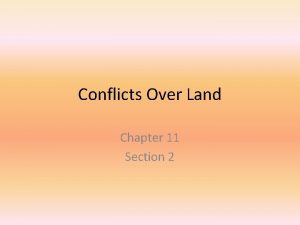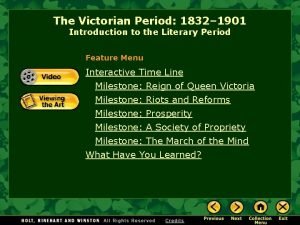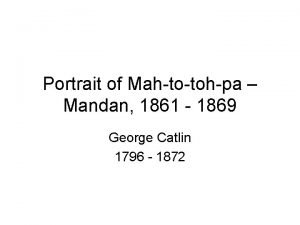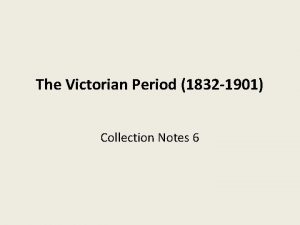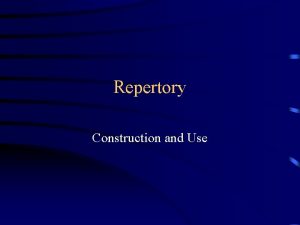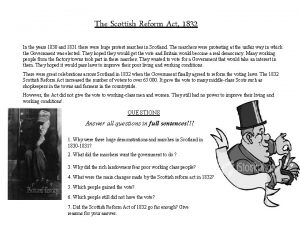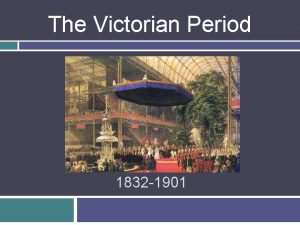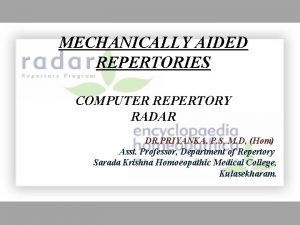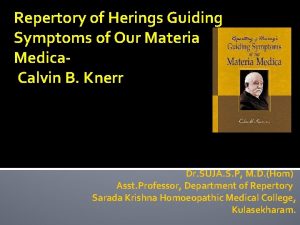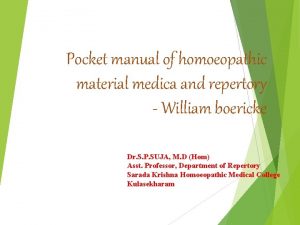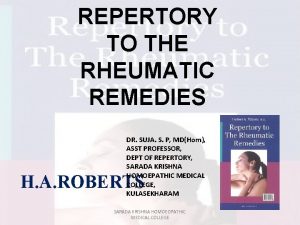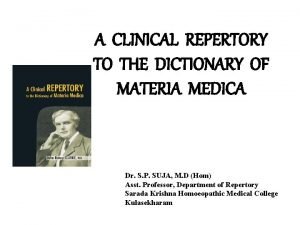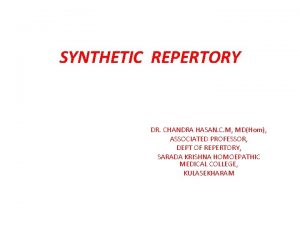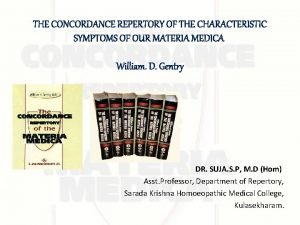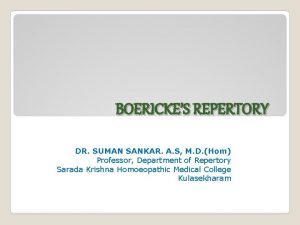IMPORTANT YEARS IN THE HISTORY OF REPERTORY 1832




















- Slides: 20

IMPORTANT YEARS IN THE HISTORY OF REPERTORY 1832 1833 1835 1836 Boenninghausen’s Repertory of the Anti-psorics with a preference by Hahnemann. Glazor: First Alphabetical Pocket Repertory, Leipzig, 165 pp. Weber – Pescheir: Repertory of Purely Pathogenetic Effects – prefaced by Hahnemann, 376 pp. Boenninghausen: Repertory of Medicines, Which are Not Anti – psoric. Dr. Jahr ‘ s Symptom Repertory, three volumes in German language. Later he published a repertory on the glands, bones, mucous membranes, ducts and skin disorders. Boenninghausen: An Attempt Showing the Relative Kinship of Homeopathic Medicines (Verwadschaften repertorium).

IMPORTANT YEARS IN THE HISTORY OF REPERTORY Page: 2 1837 Ruoff: A repertory published at stuttgart, 236 pp. 1838 A repertory published in Allentown Academy by C. Hering. 1840 Rouff: A Repertory of Nosology, 254 pages translated by Okie Humphry and Published in english in America in 1845. 1843 Laffitte (one of the first persian homeopaths): A Homeopathic Repertory of Symptomology. First original repertory in French, 975 pp. 1846 Boenninghausen’s Therapeutic Pocket Book. 1847 Hempel: Boenninghausen’s Repertory, 500 pp. 1848 Clotar Muller: Systematic Alphabetical Repertory, 940 pp. 1849 Mure: Repertory, 367 pp. 1851 Bryant: An Alphabetical Repertory, New York, 352 pp. 1853 Possart: A Repertory of Characteristic Homeopathic Remedies, Cothen, 700 pp.

IMPORTANT YEARS IN THE HISTORY OF REPERTORY Page: 3 1854 1859 Lippe : A Repertory of Comparative Materia Medica, U. S. A. , 144 pp. Cipher: Repertory by English Homeopaths, 600 pp. Enlarged edition in 1878 Drysdale Dudgeon, Atkins, and Stokes, 1030 pp.

About this time in England , the following repertories were in use: a) Buck's Regional Symtomatology and Clinical Dictionary. b) Hempel’s Repertory. c) Curie’s Repertory. d) Hahnemann’s Society Repertory, by Drysdale Dudgeon.

About this time, American homoeopaths were busy compiling repertories: repertories They were 1873 Berridge: Repertory of the Eyes, published in England. 1874 Granier of Nimes. Homoeoluxicon in two volumes. 1879 C. Lippe: Repertory of the more Characteristic Symptoms of the Materia Medica, 332 pp. 1880 T. F. Allen: Symptom Register. 1881 Hering: Analytical Repertory. 1890 Gentry: The Repertory of Concordances in six volumes, 5500 pp. 1896 Knerr: The Repertory to Hering’s Guiding Symptoms.

Note: 1) One of the earliest repertories was by Hartlaub, published in 1828 at Leipzig. In 1830, Weber compiled in German, a repertory, consisting of 536 pages, “Systematische darste Llungder Anti-psoricche Arneimimittal. ” Both these works are not much know to the profession. 2) In 1885, Fr. Augustus Muller, published the ‘ Manual of Homeopathy’ which was the first Indian repertory.

Kent’s Repertory: During the last quarter of the 19 th century, the area of repertory became overcrowded with an unusually large number of repertories of different kinds. This created chaos and confusion in the profession, and prepared a suitable ground for the emergence of a repertory, well organized, systematically planned, and based on a sound philosophy. This was successfully accomplished by Kent in 1897.

Era of Regional Repertories: This last quarter of the 19 th century was also Important in the history of the repertory in one more respect. Many stalwarts started making notes of their clinical experiences and published several clinical and regional repertories. 1873 1880 1883 Repertory of Eyes by Berridge. Desires and Aversion by Guernsey. Repertory of Modalities by Worcester. Repertory of Hemorrhoids by Guernsey. Repertory of Respiratory Organs by Lutze. Repertory of Neuralgias by Lutze. Repertory of Intermittent Fevers by W. A. Allen. Repertory of Fevers by H. C. Allen. Repertory of Foot Sweat by O. M. Drake. Repertory of Sensation, as if by Holcomb.

Era of Regional Repertories: page 2 1884 1892 1894 1899 1904 1906 Repertory of Cough and Expectoration by Lee and Clarke. Repertory of Digestive System by Arkell Mc. Michel. Repertory of Rheumatism by Perkins. Repertory Therapeutics of Respiratory System by Van Denbug. Repertory of Rheumatism by Pulford. Repertory of Eczema by C. F Mills Paugh. Repertory of Headaches by Knerr. Repertory of Appendicitis by Yingling. Repertory of Labor by Yingling. Repertory of Urinary Organs by A. R. Morgan. Clark’s Clinical Repertory of the Uterine Therapeutics by Minton. Repertory of the Head by Nierdhard. Boger’s Times of Remedies. Repertory by P. F Curie.

Era of Regional Repertories: page 3 1908 1920 Repertory Part of Raue’s Special Pathology. Repertory by Boericke. Repertory by Dr. Sarkar. Repertory of Respiratory Diseases by Nash. Repertory of Mastitis by W. J. Guernsey. Repertory of Throat by W. J. Guernsey. Shed's Clinical Respiratory. Repertory of Diarrhea by Bell. These repertories paved the path for further repertories and therapeutic books, which are available on various symptoms and diseases.

Post-Kentian Repertories: After the publication of Kent’s magnum opus, very few exhaustive repertories were published. But there a few worth mentioning. Clark: A Clinical Repertory, 1904. Boger: Boenninghausen’s Characteristics and Repertory, 1905. Boericke: Clinical Repertory, 1927. Boger: Card Repertory, 1928. Repertory with Synoptic Key, 1931. Times of Remedies and Moon Phases, 1937. Roberts: Sensations as if, 1937. Roberts: Rheumatic Medicines. Jugal Kishore: Kishore Card Repertory, 1959. Phatak: Phatak’s Repertory, 1963. Barthel and Will Klunker: Synthetic Repertory, 1973.

Post-Kentian Repertories: page 2 Kunzli Jost: Kent’s Repertorium Generale, 1990. Murphy Robin: Homeopathic Medical Repertory, 1973, Indian edition 1994. Frederik Schroyens: Synthesis (fifth version) 1993. Roger Von Zandvoort: Complete Repertory, 1996. Tiwari Shashi Kant: Homeopathy and Child Care, 1998. Repertories of Nosodes and sarcodes 1999 (Boericke). Mechanical aids: Dr. Patel’s Adiovisual Homeopathic Repertory. Computer Repertories.

CLASSIFICATION OF REPERTORIES The number of repertories has been progressively increasing since the time of mater Hahnemann. Today there are more than 200 repertories available to the profession. There are various types of repertories, which can be helpful for different purposes. Hence, it is necessary to classify them, so that the busy practitioner can utilize the right repertory at the right time. Repertories have been classified into various groups by different authors, but no standard classification prevails. The most comprehensible classification would be as follows:

1) Based on Philosophic Concept: These repertories have distinctive principles of their own. Therefore, cases have to be selected to fit them with the principles. Even to understand these repertories, their philosophic concept must be known. In these repertories the symptoms may not be found in the language of the materia medica, but the symptoms change their form to fit into the arrangement of the repertories. These repertories belong to logical utilitarian group. As stated above, repertories have their own distinctive philosophies. On this basis they are further classified :

Particulars: Here the generals are given prime importance, then follow characteristic particulars. Examples: Repertory of Homeopathic Materia Medica by Dr. J. T. Kent, Lippe’s Repertory, Synthetic Repertory by Dr. Barthel and Dr. Will Klunker, Kent’s Repertorium Generale by Kunzli, Homeopathic Medical Repertory by Robin Murphy, Synthesis by Fredrick Schroyens, Homeopathy & Child Care by Dr. Shashi Kant Tiwari.

Generals: On philosophic concept of totality, based on the doctrine of analogy and concomitants. Example: Therapeutic Pocket Book by Boenninghausen. Based on complete symptom, concomitant, and pathological general: Examples: Boenninghausen’s Characteristics and Repertory, and Synoptic Key of Materia Medica, both, by Boger.

Philosophy These repertories are mostly used for the purpose of reference and not for systematic Repertorization. They help use to refer to symptoms without much variation in the language of provers. They belong to what is known as the puritan group. Example: Knerr’s Repertory Hering Guiding Symptoms and The Concodance Repertory of the Materia Medica by Gentry, in 6 volumes.

3) Clinical Repertories: These repertories have many clinical rubrics under different systems, and medicines are grouped against the name of disease. They are sub-divided as follows: a) Covering the whole: Examples: Clinical Repertory appended to Boericke’s Materia Medica, and Clinical Repertory by J. H. Clarke. b) Covering the regions: They deal with the disease condition or a part. Examples: On special parts. Berridge’s Eyes. Morgan’s Urinary Organs. Minton’s Uterus. On Clinical conditions. Robert’s Rheumatic Medicines. Bell’s Diarrhea. Allen’s Repertory of Intermittent Fever.

4) Card Repertories: Slips of cards arranged systematically facilitate the work of finding out remedies. Mostly in consists of punched cards. Examples: Kishore’s Card Repertory. Boger’s Card Index. Field’s Card Repertory. P. Shankaran’s Card Repertory. Sharma’s Card Repertory.

5) Mechanically – Aided Repertory: Computer repertories: CARA. RADAR. Organon 96. MAC Repertory. Dolphin. Hompath, etc.
 Alphabetical repertory examples
Alphabetical repertory examples History and evolution of repertory
History and evolution of repertory Card repertory ppt
Card repertory ppt Goat years to human years
Goat years to human years 300 solar years to lunar years
300 solar years to lunar years Four score and ten years ago
Four score and ten years ago Ceremoniality
Ceremoniality Victorian period
Victorian period 1798-1832
1798-1832 Romantic period timeline
Romantic period timeline The romantic period 1798 to 1832
The romantic period 1798 to 1832 The romantic period 1798 to 1832 summary
The romantic period 1798 to 1832 summary Bolton romanticism amp; politics 1789 1832 download
Bolton romanticism amp; politics 1789 1832 download гмайл
гмайл In 1832 the sauk chieftain
In 1832 the sauk chieftain The victorian period (1832–1901)
The victorian period (1832–1901) Model 1832 dragoon saber
Model 1832 dragoon saber George catlin (political scientist)
George catlin (political scientist) Black hawk
Black hawk 1832
1832 Victorian age 1832 to 1901
Victorian age 1832 to 1901

